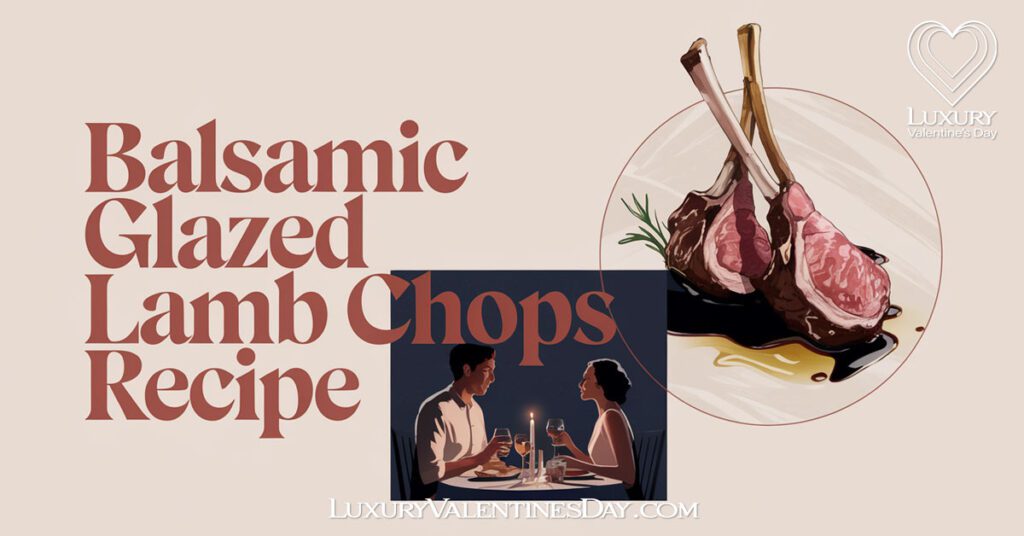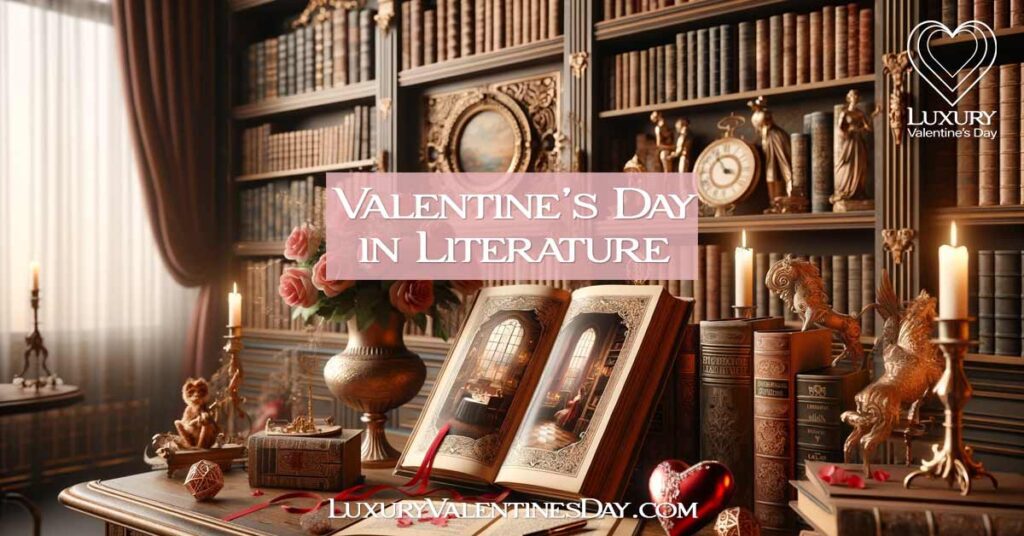
Table of Contents
ToggleUnveiling the Romantic Pages: Valentine’s Day Through the Ages in Literature
Delve into the enchanting intersection of romance and prose as we explore Valentine’s Day in the realm of literature. I bring you a unique journey through the pages of history, where love has been celebrated and immortalized by great minds. From the whimsical tales of Chaucer to the profound sonnets of the Renaissance, and the eloquent narratives of Jane Austen, this article reveals the enduring bond between Valentine’s Day and literary expression. Embark on this literary expedition to understand how authors across ages have sculpted our perception of love and festivity.
Key Takeaways
- Time Travel with Texts: Journey through different eras to see how Valentine’s Day was celebrated in literature, from ancient to modern times.
- Shakespeare to Austen: Explore how legends like Shakespeare and Jane Austen wove Valentine’s Day into their timeless tales.
- Symbols and Themes: Uncover the deeper meanings behind the Valentine’s Day symbolism found in various literary works.
- Global Love Stories: Venture into how different cultures have portrayed this day of love in their literary masterpieces.
- Literature’s Impact on Today: Understand how historical literary depictions influence our contemporary Valentine’s Day celebrations and perceptions of romance.
Love’s First Script: The Dawn of Valentine’s Day in Literature
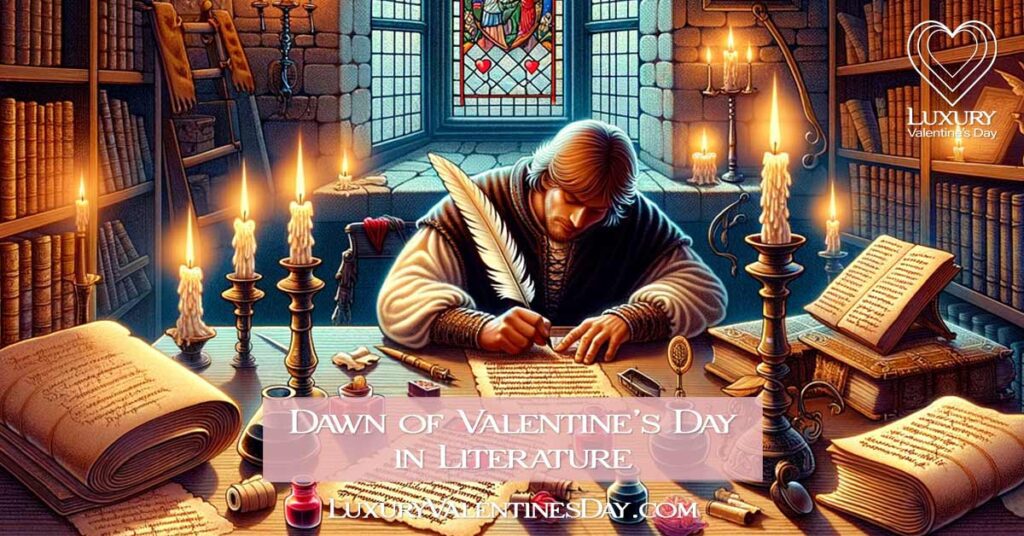
Let’s rewind the clock to the days when quills inked the first chapters of Valentine’s Day in literature. This section invites readers to explore the genesis of this romantic day within the pages of historical texts, where poets and playwrights first entwined love with the mid-February tradition. It’s a dive into the moments that shaped Valentine’s Day from a mere date in the calendar to a symbol of romance and affection in the literary world.
The Origins of Valentine’s Day in Literature
The tale of Valentine’s Day in literature begins not as a story of love, but as a commemoration of sacrifice and martyrdom. Pope Gelasius I established it in AD 496 as the Feast of Saint Valentine, honouring two different Valentines who were martyred: Valentine of Rome and Valentine of Terni [1]. However, it wasn’t until the 14th century that a romantic dimension began to bloom around the celebration, largely popularized by Geoffrey Chaucer’s “The Parliament of Fowls.” This 699-line poem, likely composed around 1381-1382, possibly in honour of King Richard II’s engagement, speaks of a parliament of birds gathering on Saint Valentine’s day to choose their mates, thus intertwining Valentine’s Day with themes of romantic love for the first time in literature[1].
This romantic portrayal had deep roots in the medieval genre of courtly love, epitomized by the story of Dante and Beatrice. Dante’s “Vita Nuova,” a collection of courtly love poems, is a testament to this idealized, often unattainable love that was more about personal character and emotional connection than physical affection [1]. Courtly love found a particular resonance on St. Valentine’s Day, especially in places like the French Court, where love poems were composed and presented in competition on this day, embodying the spirit of chivalry and devotion [1].
The tradition continued to blossom in Renaissance literature. William Shakespeare [2], in his play “Hamlet,” [3] famously referenced Valentine’s Day in Ophelia’s lament. This mention by the Bard of Avon further cemented Valentine’s Day’s place in literary lore, intertwining it with themes of love, beauty, and sometimes tragedy. In “A Midsummer Night’s Dream,” he also referred to Valentine’s Day as a time when birds choose their mates, adding another layer to the romantic lore of the day.
Chaucer, perhaps drawing inspiration from the courtly love traditions exemplified by Dante’s works, set a precedent in literature where Valentine’s Day became a canvas for exploring and expressing romantic love. Following in his footsteps, other literary figures, including Shakespeare, intricately wove Valentine’s Day into their narratives.
As we moved into the Elizabethan era and beyond, Valentine’s Day began to appear more frequently in literature, often reflecting the social and romantic norms of the time. It became a day not just for the expression of love but also for the exploration of the complex human emotions surrounding it.
This early portrayal of Valentine’s Day laid the foundation for its perpetual link to romance and its enduring presence in literature. It’s a connection that has not only enriched our literary heritage but also shaped how we celebrate love and affection in modern times.
For a deeper dive into medieval Valentine’s traditions and their literary connections, explore our medieval valentines traditions article, which further elaborates on this fascinating era.
Key Literary Works Mentioning Valentine’s Day

In exploring Valentine’s Day’s journey through literature, it’s fascinating to see how different eras have incorporated this celebration of love into their narratives. Below is a table showcasing key literary works from various periods that have mentioned or revolved around Valentine’s Day, providing a glimpse into the evolution of this romantic day in the literary world.
Table: Valentine’s Day Across Literary Eras
| Era | Work | Author | Significance |
|---|---|---|---|
| Medieval | “The Parliament of Fowls” | Geoffrey Chaucer | Early association of Valentine’s Day with romantic love. |
| 13th Century | “Vita Nuova” | Dante Alighieri | Represents the theme of courtly love, a precursor to Valentine’s Day romanticism. |
| Renaissance | “Hamlet” | William Shakespeare | Reference to Valentine’s Day in the context of courtship and love. |
| Renaissance | “A Midsummer Night’s Dream” | William Shakespeare | Mention of Valentine’s Day as a time for pairing. |
| 18th Century | “Pride and Prejudice” | Jane Austen | Valentine’s Day as a backdrop for societal norms and romantic interactions. |
| 19th Century | “Jane Eyre” | Charlotte Brontë | Depiction of Valentine’s Day within the complex romantic dynamics of the era. |
| Modern | “The Fault in Our Stars” | John Green | Contemporary portrayal of love and Valentine’s Day in young adult literature. |
This table not only highlights the diverse ways Valentine’s Day has been portrayed in literature but also reflects how the celebration of love has transcended time, evolving with societal norms and personal expressions of love. From the Middle Ages to modern times, each era brings its unique flavour to the celebration of Valentine’s Day, enriching our understanding of how literature mirrors and shapes societal values and personal emotions.
A Romantic Tapestry: The Heart of Valentine’s Day in Classic Literature
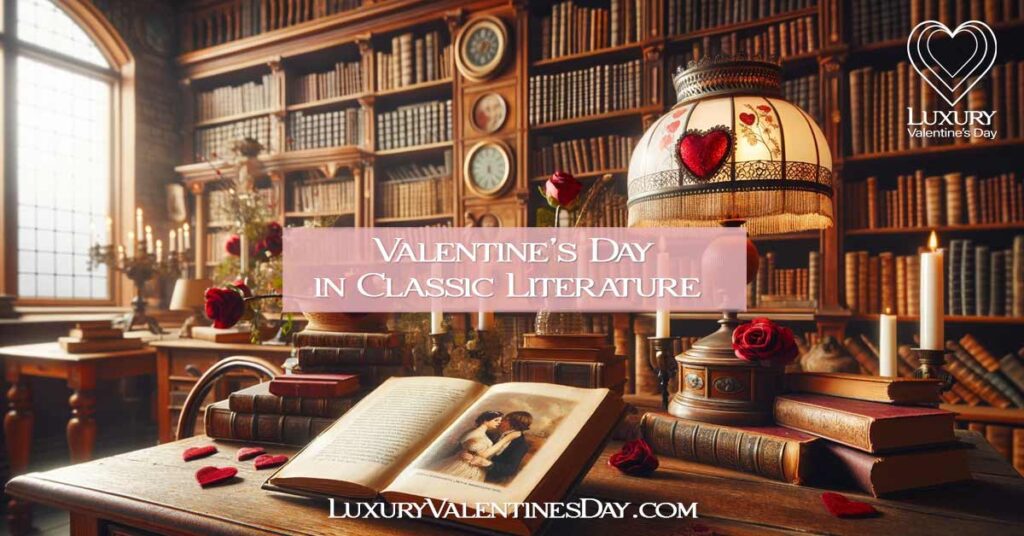
Classic literature has always been a mirror to society’s heart, and this is especially true when it comes to the portrayal of Valentine’s Day. Here I unveil the intricate ways in which classic novels and poetry have celebrated, and sometimes questioned, the essence of Valentine’s Day. It’s an exploration of the romantic ideals and societal expectations intertwined with this day of love as seen through the eyes of some of the most celebrated authors in literary history.
Analysis of Valentine’s Day in Classic Novels and Poetry
Valentine’s Day has been a recurrent theme in classic literature, often serving as a backdrop against which the complexities of love and romance are explored. For instance, in Jane Austen’s novels, the day is subtly woven into the narrative, reflecting the societal norms and romantic expectations of the Regency era. Her treatment of love, courtship, and the subtleties of romantic interaction often align with the traditions of Valentine’s Day, albeit in a manner that also critiques these societal norms.
In poetry, Valentine’s Day has been a source of inspiration for many poets. Elizabeth Barrett Browning’s sonnets, for example, echo the deep emotions associated with love and Valentine’s Day, often intertwining personal love with a celebration of the day itself. Similarly, Robert Burns’ romantic verses capture the essence of Valentine’s Day, celebrating the beauty and passion of love in a way that resonates with the themes of the day.
These classic literary works provide a rich, multifaceted perspective on Valentine’s Day, offering insights into the historical and cultural contexts that have shaped our modern understanding of love and romance. Through their narratives and verses, these authors have contributed significantly to the tapestry of Valentine’s Day in literature, making it a symbol of love that transcends time and place.
Hearts and Quills: Tracing Valentine’s Day in Shakespeare, Austen, and Romantic Verse

Embark on a literary journey to uncover how the essence of Valentine’s Day is beautifully woven into the masterpieces of William Shakespeare, the elegant narratives of Jane Austen, and the passionate verses of Romantic poets. This section explores the fascinating ways these iconic authors and poets have embedded the spirit of love and romance, synonymous with Valentine’s Day, into their timeless works. From the tragic romance in Shakespeare’s plays to the intricate courtship rituals in Austen’s novels, and the intense emotions in Romantic poetry, we delve into the heart of Valentine’s Day as seen through the lens of classic literature.
Shakespeare’s Plays
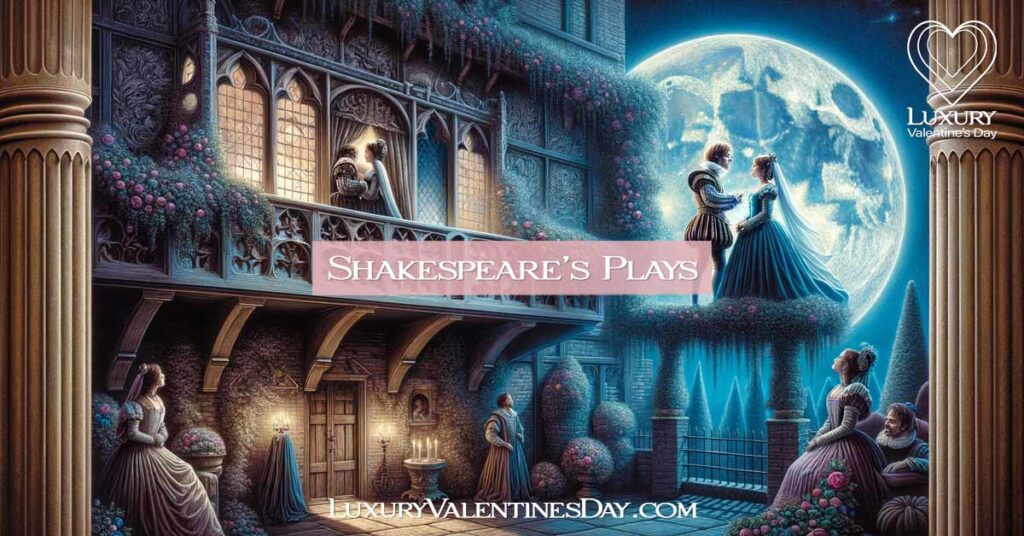
In Shakespeare’s plays, Valentine’s Day is mentioned, and highlights his incorporation of the holiday as a backdrop for exploring themes of love and romance.
In “A Midsummer Night’s Dream,” [4] Shakespeare directly references Valentine’s Day, intertwining various love stories that culminate in romantic unions. The play humorously explores the complexities and whimsical nature of love, befitting the spirit of Valentine’s Day. For example, Theseus, in Act 4, Scene 1, jestingly remarks, “St. Valentine is past: Begin these wood-birds but to couple now?” This line subtly ties the play’s romantic entanglements with the tradition of finding mates on Valentine’s Day.
Another notable mention is in “Hamlet,” where Ophelia, in her descent into madness, sings, “Tomorrow is Saint Valentine’s day, All in the morning betime, And I a maid at your window, To be your Valentine.” This poignant moment in Act 4, Scene 5, reflects the intertwining of love and tragedy, a recurring theme in Shakespeare’s portrayal of romantic relationships.
Shakespeare’s portrayal of love, aligning with Valentine’s Day themes, is a blend of passion, humor, and sometimes tragedy. In “Romeo and Juliet,” the young lovers’ intense passion and tragic end encapsulate the dramatic and profound aspects of love, reflecting the deep emotions often associated with Valentine’s Day. For instance, Romeo’s declaration, “But, soft! what light through yonder window breaks? It is the east, and Juliet is the sun,” epitomizes romantic adoration.
Shakespeare’s work offers a rich exploration of love’s many facets, from its joyous beginnings to its often-tragic ends, paralleling the varied emotions and narratives associated with Valentine’s Day.
Jane Austen’s Novels

Jane Austen [5], known for her keen observation of 19th-century courtship and romance, subtly weaves themes akin to Valentine’s Day into her novels. In “Pride and Prejudice,” [6] the dance between Elizabeth Bennet and Mr. Darcy underlines the era’s courtship rituals, reminiscent of Valentine’s Day’s focus on romantic attraction and social matchmaking. For example, Elizabeth’s playful and intelligent banter with Darcy during the Netherfield Ball showcases the nuanced dance of Regency-era courtship.
In “Emma,” [7] the eponymous character’s role as a matchmaker echoes the Valentine’s Day spirit of love and romance. The novel navigates through various romantic misadventures and matchmaking efforts, culminating in realizations of love, as seen in Emma’s own journey to recognizing her feelings for Mr. Knightley. Austen’s depiction of Valentine’s Day-related themes is more implicit, focusing on the subtleties of emotion, societal expectations, and the complexities of relationships.
Austen’s novels, though not directly referencing Valentine’s Day, beautifully encapsulate its essence through the lens of romance, courtship, and the social intricacies of the Regency period.
Romantic Poetry

The Romantic era in poetry is characterized by an intense focus on emotion, nature, and, most notably, love — themes that resonate deeply with Valentine’s Day.
Lord Byron [8]: Known for his passionate and sometimes melancholic love poems, Byron’s works often reflect the fervent emotions associated with Valentine’s Day. For instance, in “She Walks in Beauty,” Byron expresses admiration and love through the portrayal of a woman’s beauty, akin to a lover’s adoration on Valentine’s Day.
Percy Bysshe Shelley [9]: Shelley’s poems frequently explore the ethereal and sublime aspects of love. In “Love’s Philosophy,” Shelley intertwines natural elements with themes of unity and romantic love, capturing the essence of Valentine’s Day’s celebration of love as a universal, binding force.
John Keats [10]: Keats’s poetry is filled with sensual and vivid imagery that celebrates love and beauty. “Bright Star,” for example, is a sonnet that expresses a deep, enduring love, mirroring the kind of eternal devotion often idealized in Valentine’s Day sentiments.
The Romantic poets, through their vivid and emotive language, capture the spirit of Valentine’s Day, celebrating love in its most passionate, idealistic, and sometimes melancholic forms.
Modern Literary Interpretations

We now turn the page to contemporary literature, exploring how modern authors reinterpret Valentine’s Day’s timeless themes. From novelistic explorations of love in the digital age to poetic musings that resonate with today’s generation, we see how current writers redefine romance and Valentine’s Day. This journey through modern literary interpretations reveals how Valentine’s Day continues to inspire, challenge, and reflect our evolving understanding of love, romance, and relationships in a rapidly changing world.
How Contemporary Literature Portrays Valentine’s Day
In the realm of contemporary literature, Valentine’s Day is often depicted with a blend of traditional romanticism and modern-day realities. Authors and poets of the 21st century approach the concept of love and Valentine’s Day with a fresh perspective, reflecting current societal attitudes and experiences.
Example in Novels: A notable example is John Green’s “The Fault in Our Stars.” This novel, while not directly centered around Valentine’s Day, encapsulates the depth and complexity of young love in the modern world. It portrays the celebration of love in the face of adversity, a theme that resonates with the spirit of Valentine’s Day.
Example in Poetry: Modern poets, like Rupi Kaur, often use Valentine’s Day as a backdrop to explore themes of self-love, healing, and the more nuanced aspects of relationships. Their work reflects a shift from traditional romantic ideals to a more inclusive and diverse understanding of love.
Shifts in the Representation of Romance and Valentine’s Day in Modern Times

In recent times, literature has witnessed a significant shift in the portrayal of romance and Valentine’s Day. Contemporary narratives often move away from idealized love stories to embrace more realistic, diverse, and sometimes unconventional representations of love. This change reflects society’s evolving understanding of relationships, recognizing the complexities and varied forms love can take.
Modern literature frequently addresses themes such as the challenges of maintaining relationships in a digital age, the recognition of LGBTQ+ love stories, and the exploration of self-love and independence as facets of modern romance. These themes signify a broader, more inclusive approach to Valentine’s Day – one that acknowledges not just the joy and passion of love but also its trials and complexities.
This shift is evident in works that focus on personal growth, emotional resilience, and the journey to find love in various forms, whether it’s romantic, platonic, or self-love. This contemporary approach offers a more rounded and authentic perspective on Valentine’s Day and its significance in modern society.
Valentine’s Day Symbolism in Literature
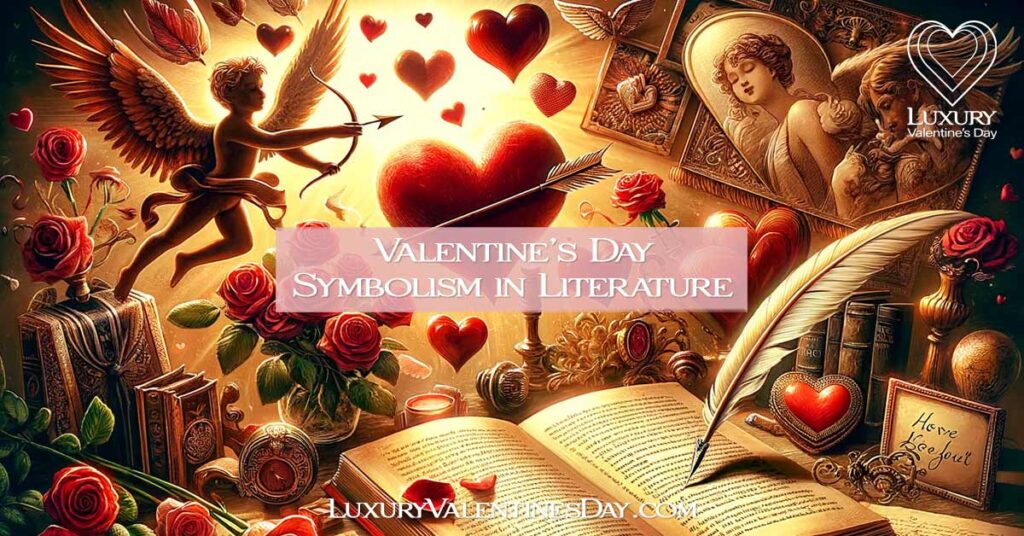
Here I delve into the rich tapestry of symbols associated with Valentine’s Day as depicted in literature. From the iconic heart imagery to the varied representations of love and romance, we explore how authors and poets across ages have used these symbols to convey deeper meanings and themes. This exploration not only sheds light on the traditional symbols of Valentine’s Day but also examines how contemporary writers have reinterpreted these motifs to reflect modern sensibilities and understandings of love.
Unraveling the Heart’s Code: Symbols of Love in Literature
In literature, Valentine’s Day is often more than just a celebration of love; it’s a complex symbol intertwined with deeper meanings. Authors and poets use this day as a backdrop to explore various dimensions of love and human relationships. For example, in Shakespeare’s works, Valentine’s Day isn’t just a romantic occasion but a reflection of love’s many faces – from its innocent beginnings in “Romeo and Juliet” to its more nuanced portrayal in “Much Ado About Nothing.” [11]
Contemporary authors also delve into these depths, using Valentine’s Day to explore themes such as the commercialization of love, the loneliness and longing that can accompany this day, and even its role in modern digital relationships. These literary works expand the symbolism of Valentine’s Day, showing it as a multifaceted, deeply emotional, and sometimes challenging aspect of the human experience.
Through these literary lenses, Valentine’s Day becomes a powerful symbol for examining the joys, sorrows, complexities, and transformative power of love in human life.
Decoding Love’s Language: The Symbolism of Valentine’s Day in Literature

In the world of literature, symbols play a pivotal role in conveying the essence of Valentine’s Day and the emotions it encompasses. This section dissects the common symbols of Valentine’s Day found in literary works, unraveling their deeper interpretations. From the iconic red rose representing passionate love to the intricate use of Cupid as a symbol of desire, these symbols enrich the narratives and add layers of meaning. Here, we decode these symbols and their interpretations across various texts, offering a glimpse into how authors and poets have used these motifs to depict the complexities and beauty of love.
- The Red Rose: Universally recognized as a symbol of love and passion, the red rose appears frequently in literature to denote deep romantic feelings. For example, in Robert Burns’ “A Red, Red Rose,” the rose symbolizes enduring love.
- Cupid: Often depicted as a cherubic figure with a bow and arrow, Cupid symbolizes the power of love and desire. In Shakespeare’s “A Midsummer Night’s Dream,” Cupid’s arrow is a metaphor for the unpredictable and sometimes irrational nature of love.
- Love Letters: As symbols of personal and intimate expressions of love, love letters in literature often signify deep emotional connection and longing. Jane Austen’s “Persuasion” features love letters that play a crucial role in rekindling a lost romance.
- The Heart: Representing love’s emotional and spiritual aspects, the heart symbol is pervasive in literature. In Emily Brontë’s “Wuthering Heights,” the heart symbolizes intense and passionate love.
This list provides a snapshot of how various symbols associated with Valentine’s Day are used in literature to convey different aspects of love and romance.
Valentine’s Day Across Cultures in Literature
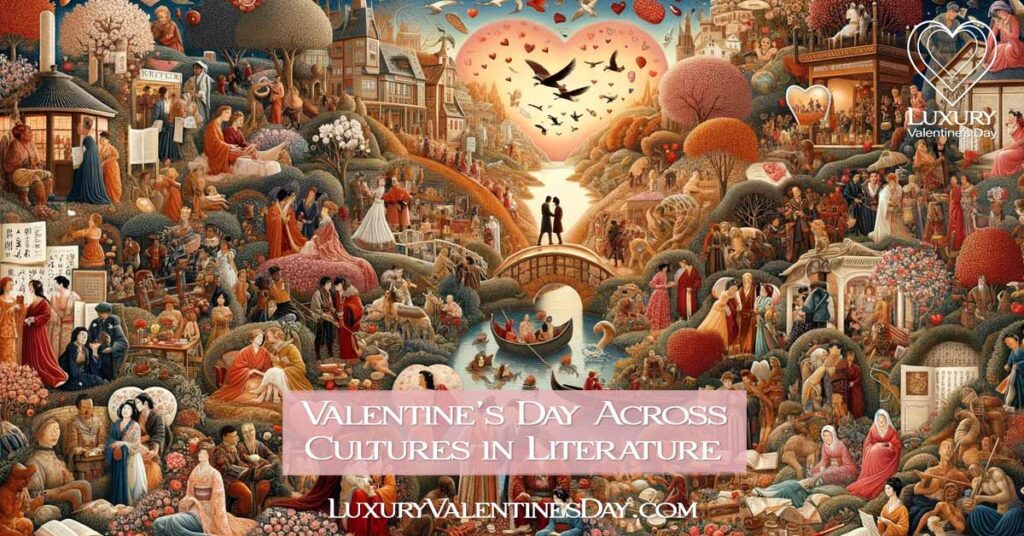
Here, we traverse the globe through the pages of literature to explore how Valentine’s Day is depicted in different cultural contexts. From the vivid portrayals in Eastern poetry to the subtle references in Western novels, we’ll see how this day of love is interpreted and celebrated across diverse literary traditions. This exploration offers a unique perspective on the universal themes of love and romance, highlighting both the shared emotions and distinct cultural expressions that Valentine’s Day evokes in literature worldwide.
How Valentine’s Day is Depicted in Different Cultural Literatures Around the World
In examining how Valentine’s Day is depicted in different cultural literatures around the world, we find a fascinating array of interpretations. In Japanese literature, for instance, Valentine’s Day often focuses on the custom of women giving chocolates to men, a practice unique to their culture. This is explored in modern Japanese fiction, where the day becomes a catalyst for exploring themes of unrequited love and social expectations.
Conversely, in Latin American literature, Valentine’s Day, or ‘Día del Amor y la Amistad,’ extends beyond romantic love to include friendships. This broader celebration is reflected in literature that emphasizes community, family ties, and platonic relationships alongside romantic ones.
Such diverse cultural portrayals enrich our understanding of Valentine’s Day, showing it as a globally recognized yet culturally distinct celebration of love in all its forms.
A World of Love: Valentine’s Day in Western and Non-Western Literature
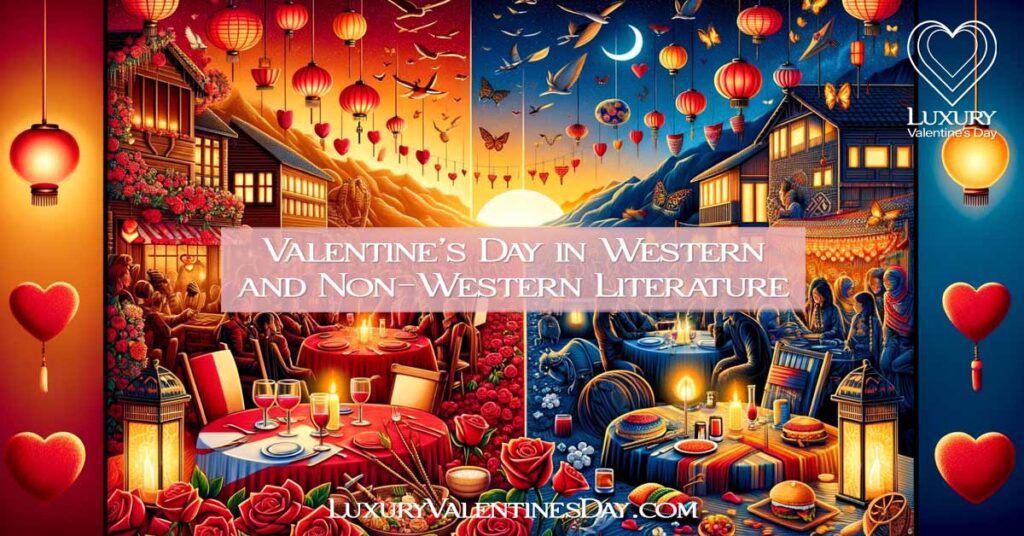
In Western literature, Valentine’s Day is often portrayed with a focus on individual romantic love. This is evident in works ranging from Shakespeare’s plays, where love often takes a dramatic, deeply personal turn, to modern novels that explore the complexities of relationships in contemporary settings. Western narratives typically emphasize personal choice, romantic gestures, and the celebration of intimate connections, often highlighting the transformative power of love on individual lives.
In contrast, non-Western representations of Valentine’s Day in literature frequently incorporate broader societal and cultural elements. For example, in many Asian cultures, such as Japan and South Korea, Valentine’s Day narratives might intertwine with local customs like gift-giving rituals, reflecting cultural practices and societal norms. In these contexts, Valentine’s Day becomes a platform for exploring themes like societal expectations, familial obligations, and even the commercial aspects of love.
African literature often infuses Valentine’s Day with local traditions and community values. The day may be depicted as an opportunity for communal celebration and storytelling, where love extends beyond the romantic to encompass familial and community bonds.
Middle Eastern literature sometimes presents Valentine’s Day through the prism of cultural and religious norms, offering a unique perspective on how love and affection are expressed within these societal constraints.
Through this deeper comparative analysis, we see that Valentine’s Day in literature is not only a universal celebration of love but also a reflection of diverse cultural narratives and social values. These varied literary representations provide a rich, multifaceted view of how Valentine’s Day is perceived and celebrated across the world.
Impact of Literature on Valentine’s Day Celebrations
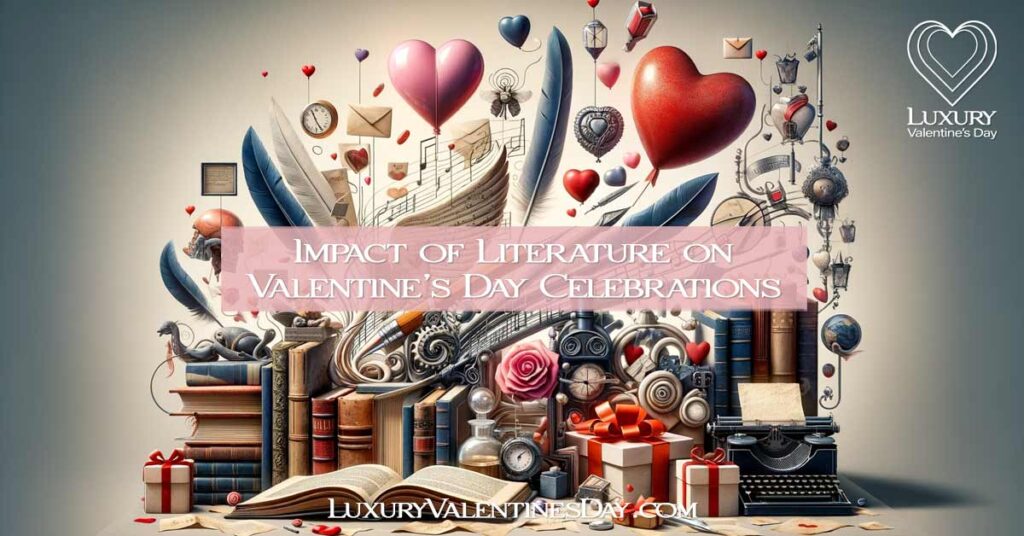
The impact of literature on modern Valentine’s Day celebrations and perceptions of romance is profound and multifaceted. Literary depictions over the centuries have significantly shaped how we perceive and celebrate this day. From the romanticized courtly love of medieval times to the complex emotional landscapes of modern novels, literature has influenced our ideas of romance and the expression of love.
In literature, Valentine’s Day often embodies the ideal of romantic love, which has translated into real-world expectations and traditions. For example, the grand gestures of love found in Shakespearean plays or the intricate courtship rituals in Jane Austen’s novels have contributed to the emphasis on special, often elaborate, celebrations of love on Valentine’s Day.
Moreover, the evolution of Valentine’s Day in literature, from a day of subtle romantic gestures to a more commercialized celebration, reflects in contemporary practices like exchanging gifts, cards, and flowers. These traditions, while rooted in historical literary depictions, have been adapted to fit modern societal norms.
In contemporary literature, with its more diverse and realistic portrayals of love, there’s a noticeable shift in Valentine’s Day celebrations. These narratives have encouraged a broader recognition of different forms of love, moving beyond the conventional romantic love to include self-love, platonic love, and the celebration of love in all its forms.
Thus, the impact of literature on Valentine’s Day is significant in both shaping and reflecting the changing dynamics of love and romance in society.
Unveiling Love’s Mysteries: Valentine’s Day in Literature FAQs
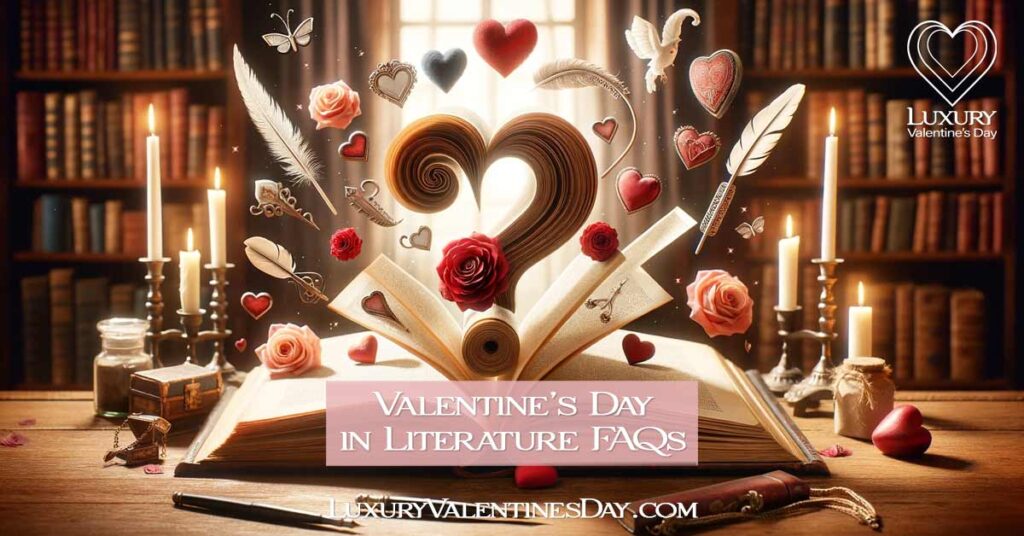
What is the oldest literary mention of Valentine’s Day?
Explore the origins of Valentine’s Day in literature, tracing back to Geoffrey Chaucer and even earlier mentions, examining how these early references have shaped our modern understanding of the day.
How did Shakespeare influence Valentine’s Day traditions through his literature?
Discover Shakespeare’s contribution to Valentine’s Day lore, particularly through his plays that intertwine love and romance, significantly influencing modern Valentine’s Day celebrations and perceptions.
Are there any notable non-Western literary works that feature Valentine’s Day?
Dive into non-Western literary works that feature Valentine’s Day, offering a glimpse into the diverse cultural interpretations and celebrations of love around the world.
How has the literary portrayal of Valentine’s Day changed over time?
Uncover the evolution of Valentine’s Day in literature, from early romantic depictions to its current multifaceted representations, reflecting societal changes and the expanding definitions of love and romance.
Final Thoughts
In summarizing, this article has traced the intertwining journey of Valentine’s Day and literature, showcasing how literary depictions from Chaucer’s time to the present day have both reflected and influenced our understanding of love and romance. This exploration highlights the enduring impact of literature in shaping our celebration of Valentine’s Day, reminding us that the essence of this day goes beyond mere tradition, deeply rooted in the human experience of love, as immortalized in the timeless works of literature.
References
[1] “On Courtly Love, Romance Literature, and St. Valentine’s Day” by Julia Stimac and Margherita Palumbo for PRPH Books from https://www.prphbooks.com/blog/valentinesday
[2] William Shakespeare Biography from the Shakespear Birthplace Trust from https://www.shakespeare.org.uk/explore-shakespeare/shakespedia/william-shakespeare/william-shakespeare-biography/
[3] Hamlet (The Tragedy of Hamlet, Prince of Denmark), the entire play by Shakespeare from https://shakespeare.mit.edu/hamlet/full.html
[4] About “A Midsummer Night’s Dream”, The Royal Shakespear Company, from https://www.rsc.org.uk/a-midsummer-nights-dream/
[5] “Jane Austen: A Brief Autobiography£ from the Jane Austen Society of North America” from https://jasna.org/austen/
[6] “Pride and Prejudice ” by Jane Austen, a full book summary from Spark Notes website https://www.sparknotes.com/lit/pride/summary/
[7] “How Jane Austen’s Emma changed the face of fiction” by John Mullan, Sat 5 Dec 2015, on The Gauardian website. https://www.theguardian.com/books/2015/dec/05/jane-austen-emma-changed-face-fiction
[8] Lord Byron from https://www.bbc.co.uk/history/historic_figures/byron_lord.shtml
[9] Percy Bysshe Shelley, from the Royal Museums Greenwich from https://www.rmg.co.uk/stories/topics/percy-bysshe-shelley
[10] John Keats, from The Keats Foundation website https://keatsfoundation.com/about-keats/
[11] “Much Ado About Nothing” by William Shakespear. Folger Shakespear Library from https://www.folger.edu/explore/shakespeares-works/much-ado-about-nothing/read/
Related Posts
- First Date Questions: Master the Art of Conversation on Your Next Date
- Transform Your Kitchen with Romantic Valentine’s Day Table Decor Ideas
- Sophisticated Valentine’s Day Decor Ideas to Elevate Your Celebration
- Date Ideas That Start with G: Great and Grand Dates
- Valentine’s Day Decor Ideas to Make Every Space Romantic and Inviting
- Valentine’s Day Tray Decor Ideas: Creative Ways to Style Your Romantic Display













